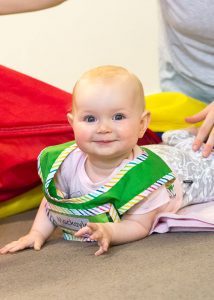Dr Jane Williams

OK. A serious topic to start, but one that needs to be emphasised, particularly as so many children are struggling to cope with the challenges of the classroom once they start school (22% in Australia) … and believe it or not, it all starts in the first years of life. Dr Steven Grossberg – a cognitive scientist, theoretical and computational psychologist, neuroscientist, mathematician, biomedical engineer, and neuromorphic technologist at Boston University, specialises in studying how the brain learns. He has developed a complex model that describes the essential processes and experiences a child must have for optimal brain development. Some of the key experiences include:
1. Movement
This is particularly crucial in infancy because the reflexive patterns of movement provide a baby with their first orientation to space and to their own self-awareness. This starts the process of thinking.
Thinking arises out of movement. In the animal world, animals with simple movement patterns have simple brains. Animals with complex movement patterns have more complex brains. Rdolofo Llinas, heralded as making a key discovery about the function of neurons in the brain, tells us: “That which we call ‘thinking’ is the evolutionary internalisation of movement,” (2001) and without movement to stimulate brain cells the brain cannot grow and connect.
2. Practice
Practice of actions is important for learning. The brain is constantly filtering information and it only selects consistent information and ignores inconsistent information. This makes practice important, as a child needs to consistently practice a new skill for the brain to embed it automatically into its repertoire of learned skills.
Babies and young children learn by a process Piaget called ‘circular reactions’ – they accidentally make a movement that gives them an outcome, they enjoy the outcome and so try to replicate the action again and again until they achieve success. In this way, skills important for learning are constructed.
3. Movement is the bridge between intuitive learning and analytical learning
When we move, we stimulate both sides of the brain differently, this enables the brain to constantly update what it knows and for us to develop into a knowing being.
4. Motivated attention is important for learning
For the brain to learn new tasks, movement alone is not enough. What is required is the child’s attention, awareness and enthusiasm. For children with neuro-developmental problems, slow movements are best, with attention and subtly, because the reduction of force and intensity increases sensitivity.
We need to pay attention quickly, at the right time, be motivated to act and then to do the appropriate action. Babies and children are motivated by curiosity, positivity and enthusiasm.
5. Spatial attention must work together with the motor systems
This helps us understand and make sense of the world around us and therefore enables us to act and respond effectively on the changing world around us.
6. As well as paying attention we need to be able to time our movements appropriately
Practice, movement experiences and adaptive timing enables us to respond at the right time to a stimulus. A mature brain learns to respond even before we have ‘thought about it’, often before or after we expect it.
Looking for movement ideas?
You can find lots of movement ideas suitable for small babies on our free online Active Babies Smart Kids website: www.absk.com.au Simply log on to our free GymbaROO series, designed to enable you to enjoy active movement ideas with your baby in the comfort of your own home. Of course, if you are attending your local GymbaROO/KindyROO centre, you will already be provided with loads of ideas!
Further information about Dr Steven Grossberg and his research can be found online. A good place to start is: https://en.wikipedia.org/wiki/Stephen_Grossberg

